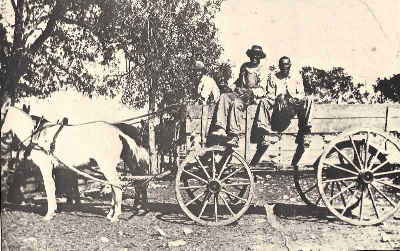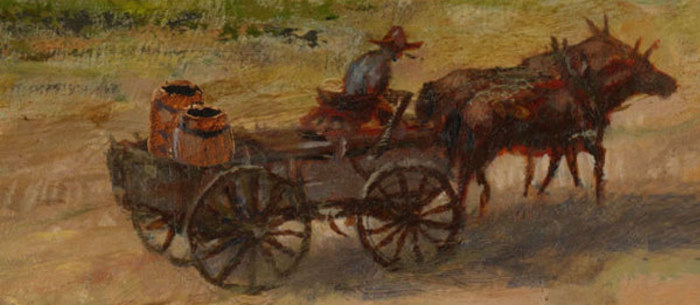
Nineteen-year-old William is returning from a visit to Antioch, a settlement of once-enslaved freedmen. William's main interest was in seeing his new girlfriend, but a trip into town by wagon was also an opportunity to purchase supplies the family needed.
As he crossed Bear Creek, he stopped to fill the large water barrels in the back of the wagon. Ransom William's property did not have easy access to water. Bear Creek was over a half mile from the cabin and no evidence of any well near the house was uncovered during the excavation. Because of the limestone lying so close to the surface of the ground, digging a well would require breaking through large slabs of rock, a difficult and expensive task. Most likely, the family hauled water from Bear Creek every day to use for cooking, drinking, cleaning and other tasks. After a heavy rain, sometimes water would run down into the pond near the corrals.
Having a wagon with two strong horses to haul barrels and other heavy farm equipment was a blessing for the Williams family.
See what the archeologists found!
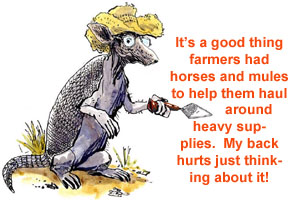
Archeologists found many artifacts that tell us horses and wagons and even carriages were used on the farm. Like pickup trucks today, wagons served several purposes. In addition to transporting the family back and forth to town, wagons were used to haul heavy tools and supplies from one part of the farm to another. Horse-labor may also have been a source of outside income if Williams used his wagons to haul freight for others.
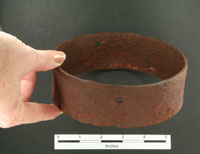
This metal “cap,” shown at right, is a wagon wheel hub that fit over the center of the wagon wheel, where the wheel attached to the axel. Grease could be placed inside the hub to help keep the wheel turning smoothly.
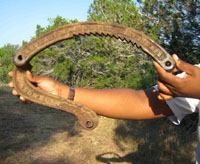
This oddly shaped metal artifact is a wagon brake ratchet, part of the braking system on a wagon. The words “Hurlbut Maf. Co. Pat, May 21 1872” is printed on one arm. The drawing is from the patent application filed in 1872. A steel framework was fastened to the side of the wagon. The brake arm was held in position by a series of notches. Interestingly, the brake could not completely stop a wagon without the horses’ cooperation. Even with the brake on, a runaway team of horses could still drag the wagon if they did not want to stop!
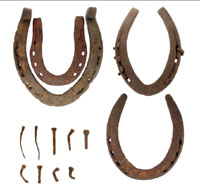
Horseshoes, muleshoes and horseshoe nails of various sizes suggest that Ransom Williams not only raised horses for his own use, but may have also raised and trained horses for others. Mules were probably employed for the heavier work around the farm such as hauling and plowing, since horses were considered far more valuable and are more prone to injury than mules. The metal “shoe” helps protect the hooves of horses and mules which are made of material similar to human fingernails but much thicker. The nails are driven through small holes in the shoe and into the hoof. Archeologists found a total of 13 horsehoes and 2 muleshoes. Muleshoes are typically larger than horseshoes and are shaped differently.
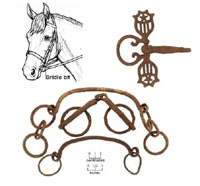
A variety of horse gear—or tack—was found at the farm, including several kinds of bridle bits. The bit is the piece that goes into the horse’s mouth. Different kinds of bits may be used for different jobs, such as individual riding and pulling wagons or carriages. Bits also vary according to the size of the horse and how quickly the horse responds to the rider’s or driver’s directions.
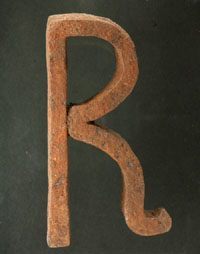
This metal “R” is part of Ransom Williams’ livestock brand. The letter has broken off of the branding iron and part of the shank, the shaft connecting the brand to the handle, can be seen on the backside. The letters “RA” were registered to Ransom Williams in April of 1872 as his horse brand according to the Travis County Register of Marks and Brands from that year.
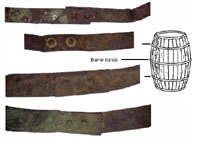
The horses and mules may have pulled wagons filled with large wooden barrels, an especially important job at the Williams farm. Archeologists found more than 40 pieces of metal barrel hoops at the site. These metal strips held together the wooden boards, or staves, that make up a barrel.
Some of the hoops show the machine-cut ends and rivets that fastened the band into a large circle. Others are crudely cut and repaired by hand indicating that Ransom made his own repairs to continue using a broken hoop. Since they did not have running water in the cabin, or even a water well, the Williams may have used barrels to haul water from nearby Bear Creek for daily use. Water was a critical resource for the family and the livestock on the farm.
